Lennox Passage The Cats Creep
After reading this page, try the 19-question quiz
SOURCE: proposed update for Round Hill's conservation character statement See page 70-73
A narrow stone staircase of six flights, a public right of way rising from Roundhill Crescent to Wakefield Road is now known as the Cats creep, formerly Lennox Road.
Planned initially as a radial street (mirroring D’Aubigny Road), Lennox Road was laid out for building in 1862 and still under construction in 1869. The Round Hill Park Estate plan suggests there was an intention to build a house on the west side. However, the plan was abandoned because the road was too steep for horse-drawn transport, with Wakefield Road and Ashdown Road developed as alternative routes.
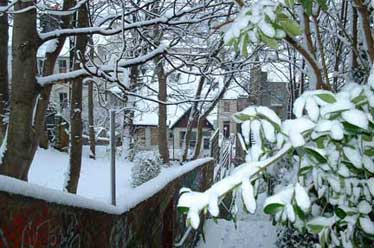
By 1898, there was a planning proposal (resubmitted in 1900 and granted on 21st June that year) to turn the unsuccessful Lennox Road into the narrower passageway of steps which remain today. See East Sussex Record Office DB/D/52/1356A and DB/D/52/1423.
By 1900, the Cats Creep was known as Lennox Passage, though this name has gone out of use. The Cats Creep steps form a public right of way, providing a shortcut to Upper Lewes Road and Lewes Roads.
In early spring, the steps also provide crossing points for toads, frogs and newts. Since 2019, the Cats' Creep has been registered with the leading amphibian charity, Froglife as an official ‘Toad Crossing’ site. After dusk local residents armed with torch, notebook & pencil have held Toad Crossing Patrols to alert people to the amphibians and to count them. See Toads on the move.
To the north and south of the Cats Creep steps is the most precious of Round Hill’s green ribbons. Some see this as part of a greenway which stretches from Old Steine, through Valley gardens, beyond the Level through Park Crescent, east of Wakefield / Richmond Roads through to Woodvale and Tenantry Down. Richmond Road, itself, is part of the town corridor of the South Downs Way Ahead Nature Improvement Area.
The open spaces to the north and south of the Cats Creep are not owned by adjacent houses in Richmond Road and Wakefield Road, but by houses some way along both roads. The green space to the north includes land which was likely to be used as drying field by William and Sarah Tidey at the Primrose Laundry in the 1890s before their move to larger premises in Crescent Road.
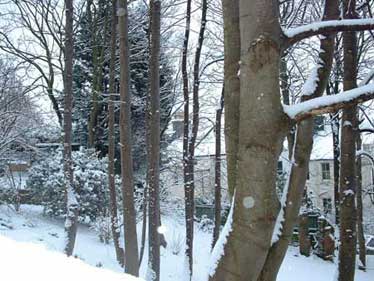
More recently, many Round Hill residents (led by those living in Richmond Road, Wakefield Road and Roundhill Crescent) fought hard to protect this privately owned open space from development. In June 2006, planning application BH2006/01501 was registered proposing the erection of 3 houses, 1 flat and 1 maisonette on land to the rear of 2-10 Richmond Road.
Brighton and Hove City Council’s planning committee refused to grant planning permission firstly because the development would fail to preserve or enhance the character and appearance of the Round Hill Conservation Area. The loss of the green open space would fail to protect or enhance the historic street layout of the area and would seriously harm the quality of views into the conservation area.
Secondly, the development would lead to an unacceptable loss of urban open space which is considered important in the context of the conservation area and for its high amenity value which is enjoyed by local residents.
To the south of the Cats Creep is open space which is equally valued by users of the alleyway and neighbours in Wakefield Road and Roundhill Crescent. It was at one time an orchard.
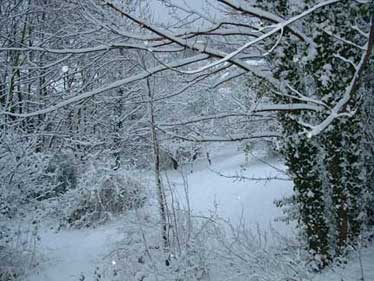
In 2011, planning application BH2011/03323 proposed the erection of a detached two-storey building which had the footprint of a house and was described as an earthship. It was argued that Fern Villa, a 1879 house which stands alone on land to the rear of Wakefield Road, constituted the beginning of a new building line.
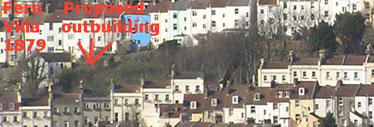
Large numbers of residents again responded by vigorously opposing the proposal. There was even a dedicated Cats Creep Campaign website which pointed out the incongruity of placing a modern development right next to one of Round Hill's most valued Victorian buildings. It warned that starting a new building line next to Fern Villa would spell the end of protection of the only green open space we have in Round Hill. This space is totally within our conservation area and gets a special mention in the (2005) conservation area character statement. The value of long views into the Round Hill conservation area from public vantage points such as Race Hill and Tenantry Down was also emphasised. The application was refused in February 2012 by 10 votes to 2.
Extract from Round Hill’s conservation area character statement adopted 20th October 2005.

The Cats' Creep extra
by Pam Blackman from The Round Hill Reporter March 2003
The term Cat Creep, like Twitten (another local term), describes a route which whilst officially a public right of way, is more often a secret space shared by a few residents who may use it as a shortcut or remember playing there as children. For those of us who like to poke around the byways of the area, it offers fascinating glimpses of back gardens and, in particular, the orchard still occupying part of the 'green' area between Richmond Road and Round Hill Crescent.
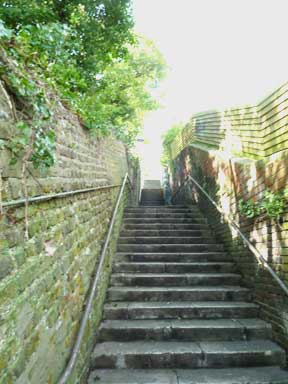
Is it dirtier and more unsavory now than people remember? Ron Burleton recalls that 'the Cat Creep was frequented by an eccentric called Charlie - a harmless itinerant - who would recite Shakespeare to the children'. Mrs Clarke (aged 93 when interviewed in 2001) remembers daily using the steps both as a shortcut from her home in Belton Road down to Round Hill Crescent where most of her friends lived, and also later on her journey between her work and her home where (as was common then) she returned each lunch time for a midday meal. Quite a trek from Wellington Road where she worked, but certainly a shortcut, and quicker than using the tram which went up Ditchling Road.
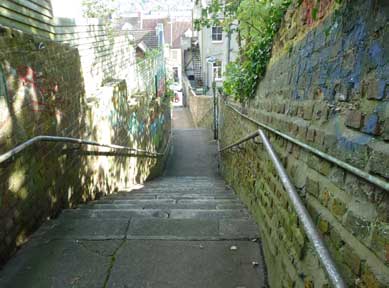
Unlike some of the other Cat Creeps in Brighton, this one was not originally intended merely as a shortcut for the local residents. It was initially wider and named Lennox Road in readiness for houses to be built along it. However this plan was eventually abandoned: Lennox Road was just too steep for coaches to negotiate!
Read more about this interesting landmark as well as other fascinating memories from former and present residents in the forthcoming book to be published by Brighton Books. A suitable title has not yet been chosen and any ideas will be gratefully received. If you wish to make suggestions or to contribute your own memories of the area to the database collection already established, please write in the first instance to the editor of the Newsletter.
Round Hill history texts
Ashdown Road | Belton Road | Crescent Road | D'Aubigny Road | Ditchling Road | Lennox Passage (The Cats Creep) | Mayo Road | Princes Crescent | Princes Road | Richmond Road | Round Hill Crescent | Round Hill Road | Round Hill Street | Wakefield Road